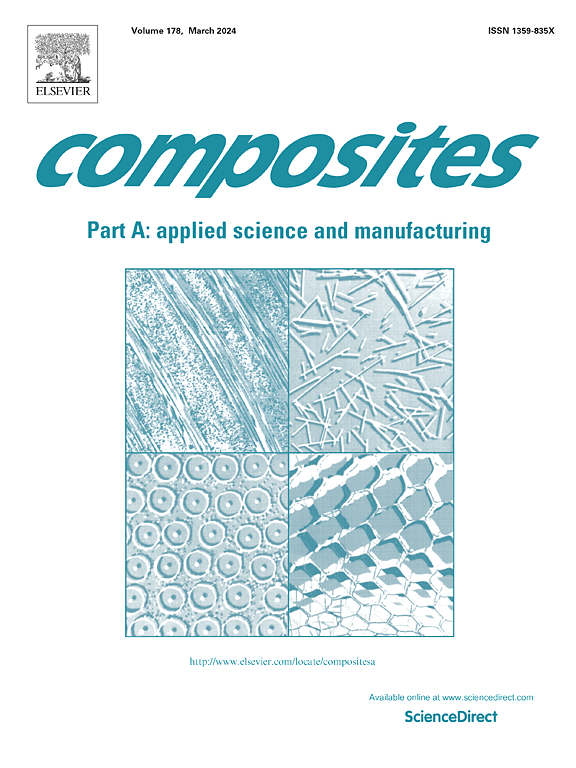热固性CF/环氧树脂与热塑性CF/PAEK复合材料层合板过程残余应力引起长期变形的机理研究与比较
IF 8.1
2区 材料科学
Q1 ENGINEERING, MANUFACTURING
Composites Part A: Applied Science and Manufacturing
Pub Date : 2025-04-30
DOI:10.1016/j.compositesa.2025.108963
引用次数: 0
摘要
本研究通过实验和数值研究了热固性CF/环氧树脂(T700G/2510)和热塑性CF/PAEK (T700G/LM-PAEK)航空级预浸料层压板的过程诱导变形(pid)和随后的长期变形(LTDs)机制。在控制条件下(60°C和50%RH),在高压灭菌器制造后的84天内测量了非对称交叉层合板的翘曲变形。利用层状热力学分析和动态力学分析(DMA)得到的材料性能,采用综合各向异性粘弹性本构律和几何非线性的有限元分析方法,对PID和LTD进行预测。实验结果表明,T700G/LM-PAEK具有较大的PID,这是由于其在成型过程中具有较大的热应变和较高的模量。相比之下,T700G/2510表现出更大的LTD,这是由于其对吸湿的敏感性更高。虽然预测T700G/2510的LTD需要加入湿度敏感位移因子,但模拟准确地再现了两种材料的PID和LTD。为了验证变形模拟,并深入了解化学成分未公开的航空级商用预浸料中树脂的粘弹性行为,进一步采用了自一致的微观力学模型。该模型从层级DMA数据估计树脂的等效粘弹性。研究结果表明,仅使用这种预浸料的标准DMA测试就可以实现宏观尺度变形预测和微观尺度树脂表征。本文章由计算机程序翻译,如有差异,请以英文原文为准。
Mechanism investigation and comparison of long-term deformations caused by process-induced residual stresses in thermosetting CF/epoxy and thermoplastic CF/PAEK composite laminates
This study experimentally and numerically investigated the mechanisms of process-induced deformations (PIDs) and subsequent long-term deformations (LTDs) in thermosetting CF/epoxy (T700G/2510) and thermoplastic CF/PAEK (T700G/LM-PAEK) aerospace-grade prepreg laminates. Warpage deformations in asymmetric cross-ply laminates after autoclave fabrication were measured over 84 days under controlled conditions (60 °C and 50%RH). A finite element analysis integrating anisotropic viscoelastic constitutive law and geometric nonlinearity was conducted to predict the PID and LTD using the material properties derived from the lamina-level thermomechanical analysis and dynamic mechanical analysis (DMA). The experimental results revealed that T700G/LM-PAEK exhibited a larger PID, which was attributed to its larger thermal strain and higher modulus during molding. In contrast, T700G/2510 exhibited a larger LTD, which was attributed to its higher sensitivity to moisture absorption. Although incorporating a moisture-sensitive shift factor was required for predicting the LTD of T700G/2510, the simulation accurately reproduced the PID and LTD for both materials. To validate the deformation simulation and provide insights into the viscoelastic behavior of the resin in aerospace-grade commercial prepregs with undisclosed chemical compositions, a self-consistent micromechanics model was further employed. This model estimated the equivalent viscoelastic properties of the resin from lamina-level DMA data. The findings demonstrated that both macroscale deformation prediction and microscale resin characterization can be achieved using only standard DMA tests on such prepregs.
求助全文
通过发布文献求助,成功后即可免费获取论文全文。
去求助
来源期刊

Composites Part A: Applied Science and Manufacturing
工程技术-材料科学:复合
CiteScore
15.20
自引率
5.70%
发文量
492
审稿时长
30 days
期刊介绍:
Composites Part A: Applied Science and Manufacturing is a comprehensive journal that publishes original research papers, review articles, case studies, short communications, and letters covering various aspects of composite materials science and technology. This includes fibrous and particulate reinforcements in polymeric, metallic, and ceramic matrices, as well as 'natural' composites like wood and biological materials. The journal addresses topics such as properties, design, and manufacture of reinforcing fibers and particles, novel architectures and concepts, multifunctional composites, advancements in fabrication and processing, manufacturing science, process modeling, experimental mechanics, microstructural characterization, interfaces, prediction and measurement of mechanical, physical, and chemical behavior, and performance in service. Additionally, articles on economic and commercial aspects, design, and case studies are welcomed. All submissions undergo rigorous peer review to ensure they contribute significantly and innovatively, maintaining high standards for content and presentation. The editorial team aims to expedite the review process for prompt publication.
 求助内容:
求助内容: 应助结果提醒方式:
应助结果提醒方式:


